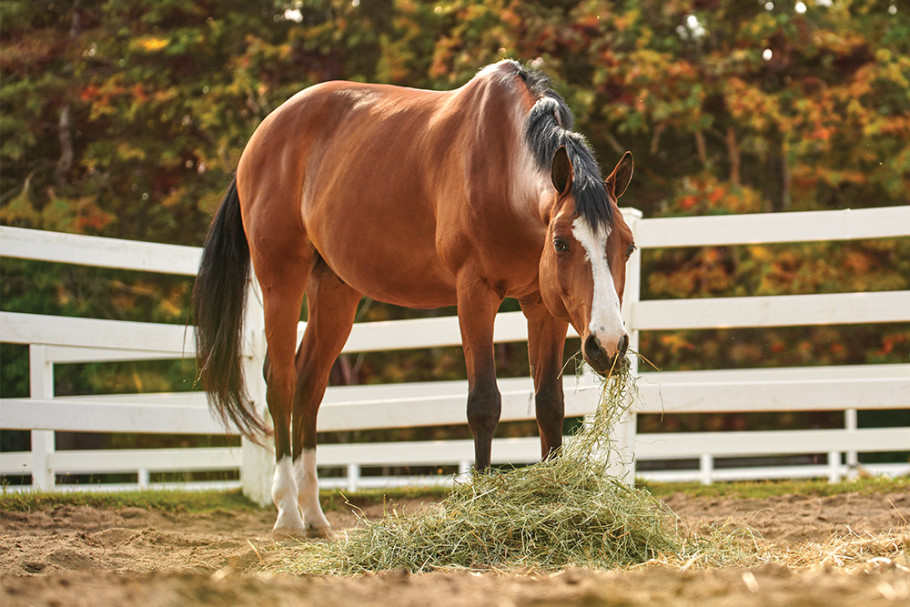Fall Horse Care
Updated December 15, 2023 | Reviewed By: Joan Maree Hinken, DVM, CVA, CVSMT
Management Strategies & Tips to Ease Your Horse Into Fall

Horses need care year-round, but special attention during the changing of the seasons can help ease horses into the different environments with their unique challenges. One of those changes is Fall, which officially begins September 23rd and ends December 21st. It’s tempting to be distracted by Halloween and Thanksgiving, but if your horse is coming off a busy summer of lessons and shows, he may need some TLC before winter arrives.
Fall Horse Care Checklist
As autumn’s cooler temps, changing colors, and shorter days roll in, keep your horse’s nutrition, exercise, and veterinary needs top of mind. Stay organized by following this fall horse care checklist:
Nutrition
- Depending on where you live, pasture may be dwindling as a forage source so it’s time to start upping the hay amount. While you’re in the hay barn, make sure you’ve got enough in stock. Be sure to check that the hay is not dusty, moldy, or weedy.
- With green grass declining, it may be time to add back in omega 3 fatty acids, Vitamins E and A, and other nutrients.
- Horses that have an abnormal insulin response (such as those with Equine Metabolic Syndrome) may need their grazing time restricted or even completely cut in the fall when grass NSC levels are high.
- Consider swapping electrolytes (to replace minerals lost in sweat) for plain salt to meet daily sodium needs and promote hydration.
- Head into the feed room and take a fresh look at your horse's diet and supplements. If your horse feels his best on a hoof, digestive, or joint supplement, it's recommended to continue supporting his systems year-round. Changes in temperature, workload, and other stressors may require some tweaking in his care and nutrition, so it's a good idea to speak with your vet or equine nutritionist to make sure he's on the best program. SmartPak's Supplement Wizard is a simple tool you can use to assess your horse's supplement plan and get recommendations to best fit his needs.
Riding in Fall Time

Speaking of workload, fall can be a great time in the saddle because of the crisp, refreshing weather and fewer bugs!
- As always, make any changes to your horse’s exercise program gradually, whether you’re adding to the intensity or duration, or subtracting from it.
- If your show season is ending, develop a plan to maintain your horse’s joints, muscles and other soft tissues, heart and lungs, and keep his mind active and engaged.
- Start thinking ahead for the long-term season by considering your horse’s winter training plans or if they’ll have that season off.
Check-in with Your Horse Health Team
Fall is the perfect time for a comprehensive wellness exam. If your horse is enrolled in SmartPak's ColiCare, a free colic surgery reimbursement program, take some time to make sure he receives his annual required care to remain eligible – physical exam, dental exam, vaccinations, and deworming. Speak with your veterinarian, equine dentist, nutritionist, farrier, massage therapist or chiropractor, too, and consider these options:
- Speak with your veterinarian about what core and risk-based vaccinations your horse may need during this time of the year. Deciding which vaccines and when to give them depends on where you live and your horse’s travel plans.
- Talk about getting a fecal egg count done on your horse and possible deworming options.
- If your horse may be prone to laminitis (such as having an abnormal insulin response that happens with Cushing’s Disease) pay extra close attention to any signs of founder. Levels of ACTH (adrenocorticotrophic hormone) naturally increase in horses during the fall time and can increase the chance of laminitis. Your veterinarian can take a sample of your horse’s blood and test for insulin dysregulation and ACTH levels.
- Ask if any plants or trees in your area may become toxic with the change of season.
- Have your vet perform a soundness exam to check for any sore spots that may have developed through the summer. Now is a great time to also ask them to check his teeth, body condition score and weight heading into the winter.
- Treat your horse to a massage or extra grooming time to recoup from summer show season.
- Pull your horse’s sheets and blankets out of storage, check them over to see if they need any care or maintenance, and make note of at what temperatures they’ll need to be used.
- While the brisk temps may urge you to want to shield your horse and keep them warm, avoid closing all the barn doors and windows. Remember that your horse needs fresh air and good ventilation for his respiratory health.
Enjoy your barn time and save plenty of time to rake those leaves!